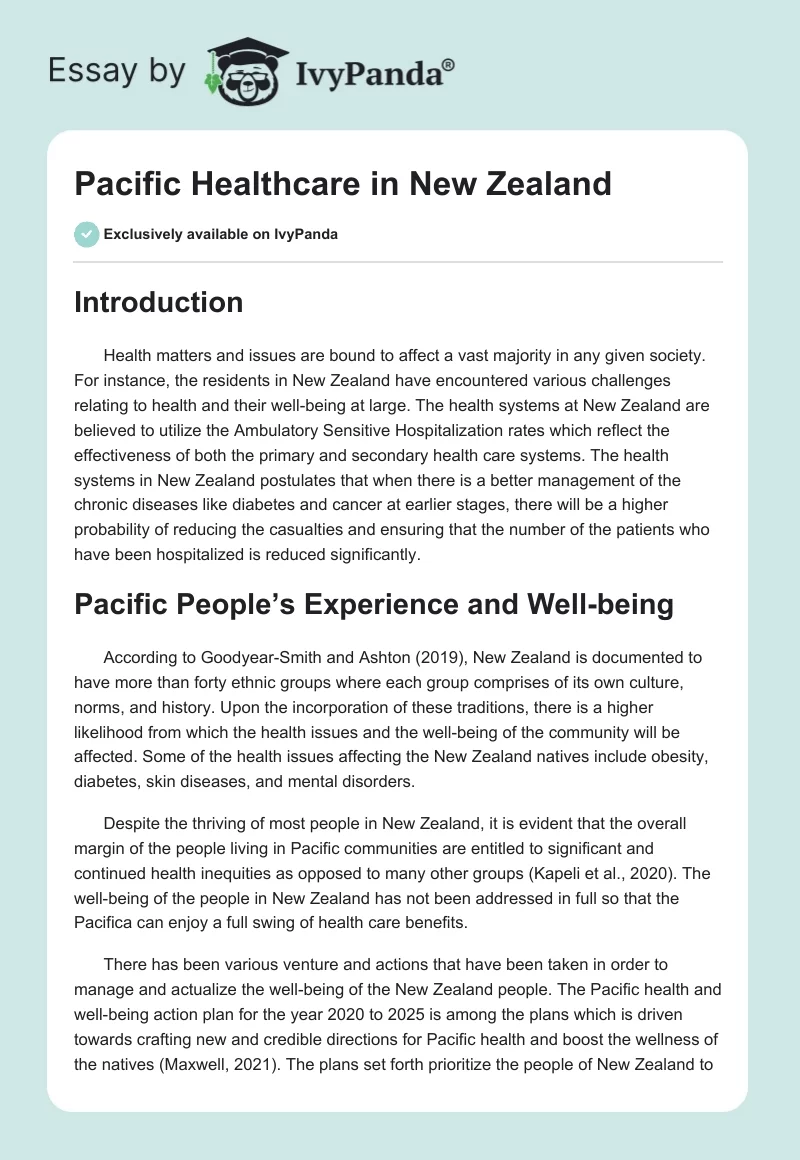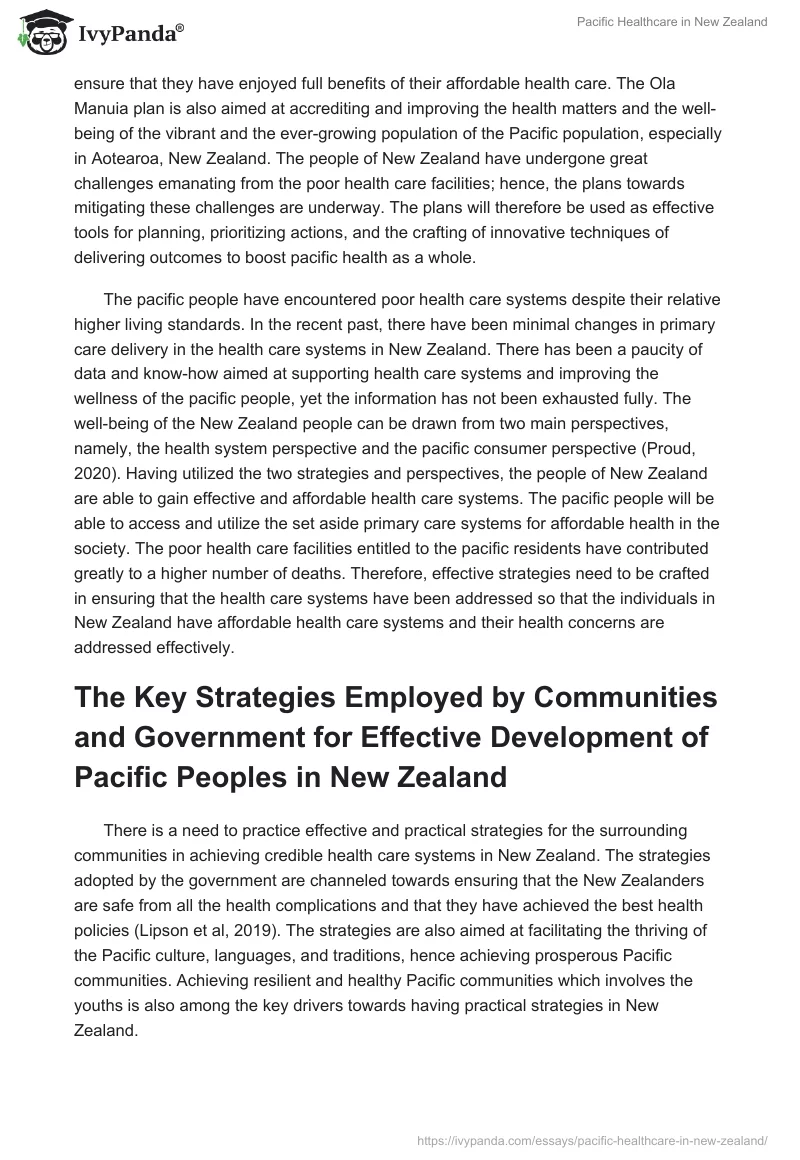Introduction
Health matters and issues are bound to affect a vast majority in any given society. For instance, the residents in New Zealand have encountered various challenges relating to health and their well-being at large. The health systems at New Zealand are believed to utilize the Ambulatory Sensitive Hospitalization rates which reflect the effectiveness of both the primary and secondary health care systems. The health systems in New Zealand postulates that when there is a better management of the chronic diseases like diabetes and cancer at earlier stages, there will be a higher probability of reducing the casualties and ensuring that the number of the patients who have been hospitalized is reduced significantly.
Pacific People’s Experience and Well-being
According to Goodyear-Smith and Ashton (2019), New Zealand is documented to have more than forty ethnic groups where each group comprises of its own culture, norms, and history. Upon the incorporation of these traditions, there is a higher likelihood from which the health issues and the well-being of the community will be affected. Some of the health issues affecting the New Zealand natives include obesity, diabetes, skin diseases, and mental disorders.
Despite the thriving of most people in New Zealand, it is evident that the overall margin of the people living in Pacific communities are entitled to significant and continued health inequities as opposed to many other groups (Kapeli et al., 2020). The well-being of the people in New Zealand has not been addressed in full so that the Pacifica can enjoy a full swing of health care benefits.
There has been various venture and actions that have been taken in order to manage and actualize the well-being of the New Zealand people. The Pacific health and well-being action plan for the year 2020 to 2025 is among the plans which is driven towards crafting new and credible directions for Pacific health and boost the wellness of the natives (Maxwell, 2021). The plans set forth prioritize the people of New Zealand to ensure that they have enjoyed full benefits of their affordable health care. The Ola Manuia plan is also aimed at accrediting and improving the health matters and the well-being of the vibrant and the ever-growing population of the Pacific population, especially in Aotearoa, New Zealand. The people of New Zealand have undergone great challenges emanating from the poor health care facilities; hence, the plans towards mitigating these challenges are underway. The plans will therefore be used as effective tools for planning, prioritizing actions, and the crafting of innovative techniques of delivering outcomes to boost pacific health as a whole.
The pacific people have encountered poor health care systems despite their relative higher living standards. In the recent past, there have been minimal changes in primary care delivery in the health care systems in New Zealand. There has been a paucity of data and know-how aimed at supporting health care systems and improving the wellness of the pacific people, yet the information has not been exhausted fully. The well-being of the New Zealand people can be drawn from two main perspectives, namely, the health system perspective and the pacific consumer perspective (Proud, 2020). Having utilized the two strategies and perspectives, the people of New Zealand are able to gain effective and affordable health care systems. The pacific people will be able to access and utilize the set aside primary care systems for affordable health in the society. The poor health care facilities entitled to the pacific residents have contributed greatly to a higher number of deaths. Therefore, effective strategies need to be crafted in ensuring that the health care systems have been addressed so that the individuals in New Zealand have affordable health care systems and their health concerns are addressed effectively.
The Key Strategies Employed by Communities and Government for Effective Development of Pacific Peoples in New Zealand
There is a need to practice effective and practical strategies for the surrounding communities in achieving credible health care systems in New Zealand. The strategies adopted by the government are channeled towards ensuring that the New Zealanders are safe from all the health complications and that they have achieved the best health policies (Lipson et al, 2019). The strategies are also aimed at facilitating the thriving of the Pacific culture, languages, and traditions, hence achieving prosperous Pacific communities. Achieving resilient and healthy Pacific communities which involves the youths is also among the key drivers towards having practical strategies in New Zealand.
KAPASA is one of the famously utilized strategies employed by the New Zealand community in achieving the proposed and projected outcomes in the end. The need for using the KAPASA strategy is to ensure that the policies are addressed optimally for the people in Pacific regions. The KAPASA strategy has allowed an effective move towards addressing the values, needs, and aspirations of the New Zealanders (Proud, 2020). There are a number of ways in which KAPASA has attained in ensuring that the well-being of the New Zealanders have been addressed. The key set ways include putting clear and effective data concerning vital information about Pacific people. Whenever there is sufficient data and information regarding ta certain group, it always becomes easier for an effective allocation of resources and managing the vulnerable members in New Zealand.
KAPASA strategy also sets room in ensuring that there is an effective engagement as a policy in developing, implementing, and monitoring of the transactions among the Pacific people. The strategies adopted at this juncture will allow effective allocation and management of the health care resources among the available health facilities in New Zealand and the Pacific regions as a whole. KAPASA strategy should be utilized in every phase of policy development process in instances where the pacific people are affected. The strategy used has the capacity of breaking down the process in three main categories. The first category is based on the context and the outcome, analysis and implementation, and monitoring, adjustment and evaluation (Lipson et al, 2019). The phases broken down in the strategy will be effective in manipulation and utilization of the necessary processes in managing health resources in the Pacific communities. KAPASA strategies are also believed to bring forth a platform for the government agencies in building a clear understanding of the pacific people. The understanding of the health challenges encountering the pacific people will give a positive policy development, improving the outcomes, and bettering the quality of life for the New Zealanders.
The KAPASA strategies are designed to be used in each phase of the policy development processes if at any chance the New Zealanders are affected. The KAPASA strategy will therefore be utilized in ensuring that the wellness of the pacific people is addressed effectively (Liu et al, 2021). Pacific well-being strategies are advocated in order to ensure that pacific people’s wellness and economic benefits are addressed. The strategies are aimed at modifying New Zealand public sectors and managing public funds.
All-Of-Government Pacific well-being Strategy is a technique that includes the indicators that tend to hold the government’s agencies accountable for not meeting the thresholds and the expectations set forth. The strategy sets a clear path for the improvement of the wellness of the Pacific people in New Zealand. The strategy will also improve the outcome of the Pacific communities by adopting key priorities. The key priorities include the establishment of genuine partnerships between the government agencies and the Pacific communities working towards tangible outcomes. Additionally, the heart of this strategy is to ensure that the principles and Pacific cultural values are addressed. It is documented that this strategy builds and strengthens the cultural capabilities and engagement techniques of Pacific people (Lipson et al, 2019). Therefore, the investment in the Pacific communities through the All-of-Government Pacific well-being Outcomes Technique facilitates the actualization of the targets in New Zealand.
Conclusion
In conclusion the strategies are believed to create a good rapport between the individuals in Pacific; this is due to equal allocation of resources and funding of health care systems. When the strategies are effective, the allocation of resources will be done in a manner to ensure that the community lives harmoniously. All the phases in the strategies underlie and give effective generic policies in crafting adorable outcomes to the pacific people. When effective and practical strategies are exercised, there is a higher capacity from which the wellness of the individuals in the pacific regions will be upheld. Additionally, the health care systems for the New Zealanders will take a positive turn when the strategies are addressed sufficiently; hence, drawing a higher level of satisfaction in the end.
References
Goodyear-Smith, F., & Ashton, T. (2019). New Zealand health system: universalism struggles with persisting inequities. The Lancet, 394(10196), 432–442.
Kapeli, S. A., Manuela, S., & Sibley, C. G. (2020). Perceived discrimination is associated with poorer health and well‐being outcomes among Pacific peoples in New Zealand. Journal of Community &Amp; Applied Social Psychology, 30(2), 132–150.
Lipson, S. K., Lattie, E. G., & Eisenberg, D. (2019). Increased Rates of Mental Health Service Utilization by U.S. College Students: 10-Year Population-Level Trends (2007-2017).Psychiatric services (Washington, D.C.), 70(1), 60–63.
Liu, L., Tang, Y., Baxter, G. D., Yin, H., & Tumilty, S. (2021). Complementary and alternative medicine – practice, attitudes, and knowledge among healthcare professionals in New Zealand: an integrative review. BMC complementary medicine and therapies, 21(1), 63.
Maxwell, J. (2021). Budget 2021: Government lays out cash for transition to new health system – Kaitiaki Nursing New Zealand. (n.d.).
Proud, P. (2020). Pasefika proud Pathways for change 2019-2023.


